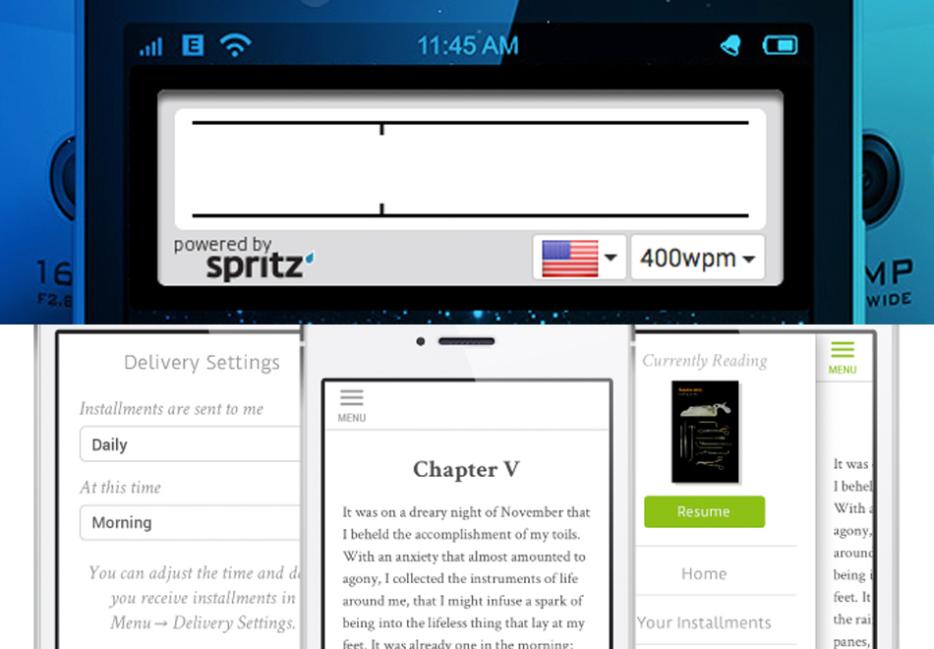People in my social media feeds have been pretty excited about “this amazing new app that lets you read a novel in 90 minutes” the past little while. They’re talking about the new speed reading app Spritz, which flashes text at anywhere from 250 to 1000 words a minute, and uses a novel technique to focus your eyes in one place as it does so. Using it is a thoroughly discombobulating, fascinating experience—try it here. The best description I’ve heard is that it’s less like reading and more like snorting words as if they were coke.
That it was so hotly discussed amongst my friends, mostly literature academics and writers, feels like a sign that we were clearly drawn to and then put off by the idea—not incensed so much as sympathetic to the need to read more, but baffled as to why anyone would want to read that fast. That ambivalence arose, I’d guess, because with Spritz, we’ve happened upon the Soylent of reading.
Soylent, if you’ve yet to come across it, is a drink, but rather than one you consume for refreshment or taste, it’s instead meant to be a kind of space-age solution to satisfy all your nutritional requirements in liquid form. The idea here is borne of the same mentality that gave us Spritz: the assumption packaged in both is that, above all else, it is the efficient, seamless delivery of stuff, be it nutritional or intellectual, that is the ultimate goal.
Easy as it is to criticize the mindset that leads to these kinds of products, though, they are each ostensibly symptomatic reactions to a broader anxiety: that in the glut of too much information, whether about health or the world, one fitting response is to try to be as robot-like as possible—to substitute the simplicity of input-output for the difficult complexities of culinary pleasure or literary beauty.
If Spritz is the edge-case of information-overload anxiety, however, there are nonetheless more productive reactions afoot to the shifting position of the written word. Among the most promising to my mind is new app Rooster, which looks to deliver bite-size snippets of literature to phones and tablets. The idea is that because we tend to engage with “content” in fragmented form, rather than Angry Birds or Facebook on the subway, why not Goethe or Tagore—just split up into chunks? At times of your choosing during the week, whether for your morning commute or just before bed, Rooster will deliver a small part of a novel to your device, which you can then settle in to read.
There is no end to the arguments about the manner in which reading extended narrative as a kind of cultural practice is and is not damaged by the atomization of content like in Rooster, or the simple pressures on attention caused by constantly beeping phones. The nay arguments—made most convincingly and controversially by people like Nicholas Carr or Sven Birkerts—tend to assume that the very fragmentation of fiction itself harms the experience and immersion of reading: that it is the very immersion into a book over a period of time that is at the core of literature’s transformative effects.
Yet, what Rooster and similar apps do is pay less attention to the experience of reading itself and instead focus on the context within which reading occurs—something that has been, up to this point, mostly ignored. The new slogan for digital design, after all, is “mobile first,” a response to the profound shift that has led to most computing and digital reading being done on phones and computers. Most of that emphasis, however, is simply on design workflows, where the main question is, “how does this news site appear on a tablet?” What Rooster suggests, however, is that if we literary types are thinking about how to react to the changes engendered by digital media, at least one of the questions that needs answering is how do we get literature to actually fit into people’s lives?
Rooster’s response to that question is particularly enjoyable, in no small part due to the fact that, unlike the mobile-first ethos, it actually leverages mobility as an intellectual response to the proliferation of media. Instead of making a novel a thing you have to return to at various, scattered stages, Rooster delivers it to your phone over the course of weeks or months, integrating it into your life, punctuating the day-to-day with both the art and plot of an extended narrative. It’s a kind of weaving of fiction into life that recalls the “textile” roots of the term “text.” In an age of binge-watching or annual sequels for movies and games—which are consumed and then quickly discarded—intertwining a narrative into the practical structures of the everyday so that it hovers like a quiet hum at the edges of one’s consciousness is a refreshing change.
For all their techno-utopian weirdness, Spritz, Rooster, and other such apps seem to be responding to the fact that the material circumstances in which we read have changed. Though there are dimensions of these responses to be critiqued, I’m not so sure that approach is altogether a bad thing. After all, despite the opposing calls for either embracing new multimedia forms, or a return to the quiet study of print in a hushed world devoid of screens, reading in all its forms is still actually a pretty good way to deliver information and ideas.
Maybe what we really need, then, is neither an attempt to assert the primacy of, say, the printed word, nor to rush headlong into digital flights of fancy. Rather, maybe we should try to figure out where each of these tacks fits into the rearranged patterns of living—into the ubiquitous mobility of information, or the predominance of screens as mechanisms of cultural engagement—so that, finally, after many years of handwringing, we can start to develop and use tools that respond in a manner commensurate and compatible with the ways in which our relationship to the written word is changing.






